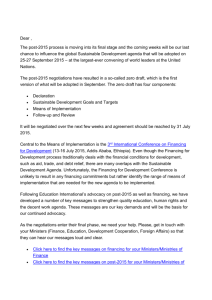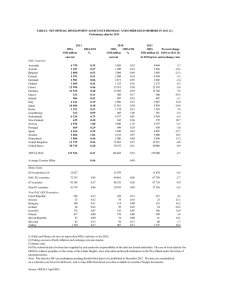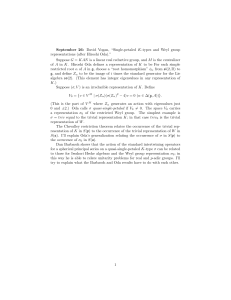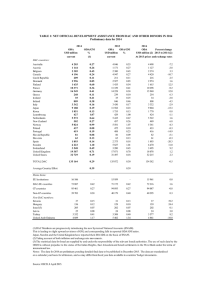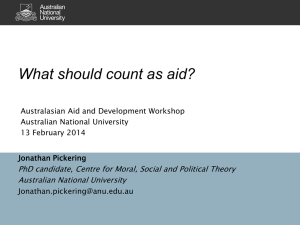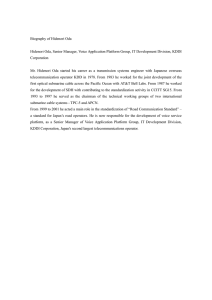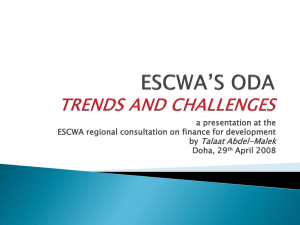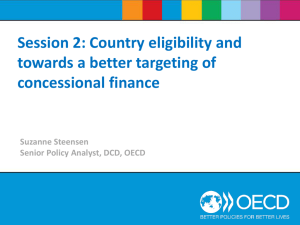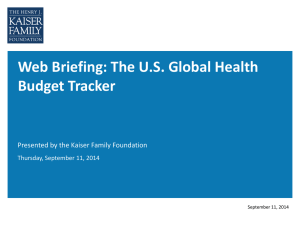Marilou Uy
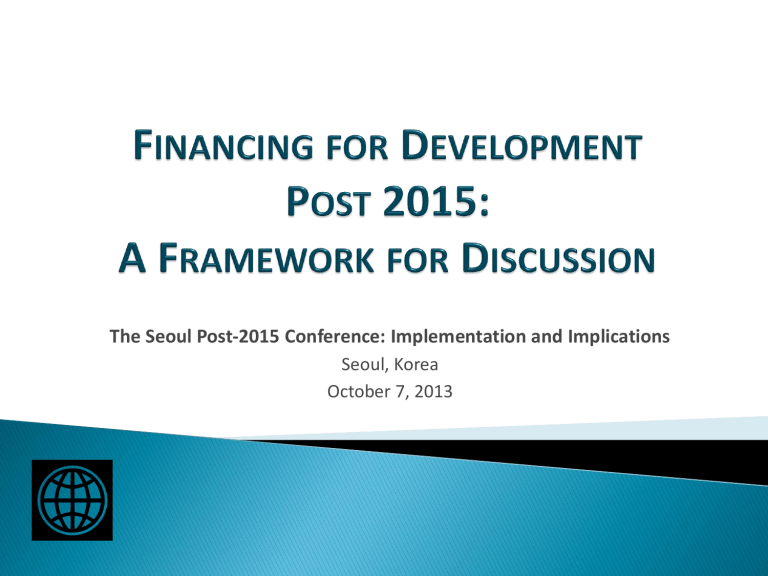
The Seoul Post-2015 Conference: Implementation and Implications
Seoul, Korea
October 7, 2013
•
The original MDGs were articulated independently of a financing framework (Monterrey 2002).
•
In a context of fiscal consolidation and an evolving landscape of development financing, discussion of post-2015 goals would need to be integrated with consideration of a supporting financing framework for implementation.
•
The purpose of this presentation is to present some elements of a financing framework for the post 2015 development goals.
2
Good policies and credible institutions to:
Increase impact of available resources
Leverage additional resources
Good policies and credible institutions enhance the impact of available resources and leverage additional resources from both domestic and foreign sources.
3
At the country level:
•
•
•
•
Design targeted, evidence-based policies and support sound institutions
Generate more revenues
Ensure efficient public spending
Promote financial deepening and inclusion
Globally:
Maximize the impact of ODA
Support new development partners
Leverage the private sector
Tap into new sources of finance
Deliver global public goods
4
15
10
25
20
5
0
35
30
Tax Revenue (in % of GDP) by Income Groups, 1994-2009
28,4 28,4
29,3
21,2
18,8
17,1
19 19,3
13,6
11,3
10
10,5
1994
High Income
1998
Middle Income
2003
Low Income
2009
Source: World Development Indicators
5
Subsidies are an inefficient means of assisting the poor: only 8% of the $409 billion spent on fossil-fuel subsidies in
2010 went to the poorest 20% of the population.
Fossil fuel consumption subsidies measure what developing countries spend to provide below-cost fuel to their citizens. High-income countries offer support to energy production in the form of tax credits or loan guarantees, which are not included in these calculations since they are directed towards production rather than consumption of the fuel.
Source: World Energy Outlook, IEA,
2011
6
Improve the allocation of resources
How do financial institutions contribute to economic growth?
Lower the cost of financial and nonfinancial transactions
Facilitate efforts to reduce and trade risks
7
Source: World Bank CFP Working Paper No.
8, Finance for Development
Source: Fragile States 2013, OECD
NB: Based on OECD definition of fragile states
8
Estimated aid from BRICS, 2003-2009 (USD billion)
4,50
4,00
3,50
3,00
2,50
2,00
1,50
1,00
0,50
0,00
2003 2004 2005 2006 2007 2008 2009
China India Russia Brazil South Africa
Source: World Bank CFP Working
Paper No. 8, Finance for
Development
For the purpose of comparison, in 2009, net ODA from DAC members was 119.8 bn USD.
9
ODA from Saudi Arabia, South Korea, and Turkey, 2003-2009 (Gross disbursements, US$ billion)
ODA from non-DAC donors excluding BRICS, 2003-2009 (Net disbursements, US$ billion)
DAC Annual Reports and IDS Statistics; Zimmerman and Smith, 2008
10
•
Global funds: trust funds that pool resources for specific issues of global importance
– Global Partnership for Education
– GAVI Alliance (formerly the Global Alliance for Vaccine and Immunization)
– Global Fund to Fight AIDS, Tuberculosis and Malaria (GFATM)
– Global Environment Fund (GEF)
•
Scattered data – available estimates for private aid to developing countries in 2009 range from USD 22 billion to USD 53 billion
•
Low estimate is equivalent to 16 percent of ODA from all donors in the same year, and up from 2005 (12 percent of ODA)
•
Private philanthropy to fragile states increasing in recent years
•
South-South philanthropy also on the rise, especially in the Arab world
•
Philanthropic giving highly sensitive to factors such as media coverage, timing, geopolitical considerations
11
M a h a r a s h t r a & T a m i l N a d u , I n d i a
C L I F F C O M M U N I T Y S A N I T AT I O N
P R O J E C T
K e n y a
P R I V AT E S E C T O R P O W E R
G E N E R AT I O N P R O J E C T
T o t a l i n i t i a l i n v e s t m e n t : $ 7 . 2 m i l l i o n
- H o m e l e s s I n t e r n a t i o n a l
- S P A R C ( N G O i n I n d i a )
- C o m m u n i t y - b a s e d O r g a n i z a t i o n s
T o t a l i n i t i a l i n v e s t m e n t : $ 6 2 3 m i l l i o n
- K e n y a P o w e r a n d L i g h t i n g C o m p a n y
- I F C
- M I G A
- C o m m e r c i a l B a n k s
Emerging
Partnerships
S a o P a u l o , B r a z i l
M E T R O L I N E 4
L a k e K i v u , R w a n d a
K I V U W AT T
T o t a l i n i t i a l i n v e s t m e n t : $ 4 5 0 m i l l i o n
- C o m p a n h i a d o M e t r o p o l i t a n o d e S a o
P a o l o
- 5 E q u i t y S p o n s o r s
- I D B
- C o m m e r c i a l B a n k s
T o t a l i n i t i a l i n v e s t m e n t : $ 1 4 2 . 2 5 m i l l i o n
- C o n t o u r G l o b a l
- E n e r g y A u t h o r i t y o f R w a n d a
- M I G A
- E m e r g i n g A f r i c a I n f r a s t r u c t u r e F u n d
- F M O
- A f D B
- B e l g i a n D e v e l o p m e n t B a n k
Source: Emerging Partnerships, IFC, 2013 and World Bank, Africa Region.
12
Total assets by type of institutional investors in the OECD, 1995-2011 (USD trillions)
13
A g Re s u l t s I n i t i at i ve
I n t e r n a t i o n a l F i n a n c e F a c i l i t y f o r I m m u n i z a t i o n ( I F F I m )
Inputs increasing yields
Outputs post harvest management
Livestock Nutrition
Linking spending to actual development outcomes
14
•
Global public goods lie at the intersection of national development priorities and global interests
•
The under-provision of GPGs disproportionately affects the poor
•
GPGs are at the center of the post-2015 agenda:
– International financial architecture
– Trade/market access
– Peace and security
– Climate change
– Communicable diseases
– Knowledge for development
– Statistical capacity-building
15
•
•
Promote targeted policies and support accountable, efficient institutions for shared growth
Mobilize domestic resources for development through:
– Broader tax coverage and increased taxation capacity
– Efficient public spending and greater accountability
– Management of natural resource revenues
– Deeper domestic financial sector
– Vibrant private sector development for job creation and shared growth
•
•
•
•
Maximize the impact of ODA
Leverage more private resources
Draw on emerging and innovative sources of finance
Deliver global public goods
The range of financing sources and instruments have different challenges and comparative advantages. Mobilizing a broad range of financing and using the right combination of instruments to meet a given goal, in a given country context, would be important tasks ahead to implement the next development framework post-2015.
16
Marilou Uy
Senior Adviser
The World Bank muy@worldbank.org
17
